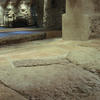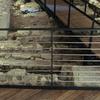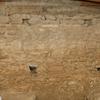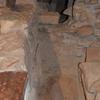Tridentum. Archaeological site of Palazzo Lodron
Following renovation work on Palazzo Lodron, in the square of the same name, it was possible to bring to light part of a quarter of ancient Tridentum.

TRIDENTVM
Around the middle of the 1st century BC, for strategic reasons, the Romans founded a new city, given the name Tridentum. It was an important garrison controlling the valley of the River Adige, which was the main road link between the Mediterranean area to central Europe.
The city had a regular layout and was delimited by city walls on three sides, to the south, east and west. Outside and running parallel to these there was a trench. On the southern side the city was protected by the river.
Tridentum covered an area of around 13 hectares. Inside, the city was subdivided into rectangular blocks delimited by streets which crossed at right angles. The entrance gates to the city or the towers were aligned with the main roads.
The archaeological area of Palazzo Lodron
The renovation work on Palazzo Lodron brought to light part of a district in the ancient city of Tridentum. In the rooms underneath this prestigious historic building it is possible to see a substantial section of the southern city walls, a stretch of road running from north to south, a tower, private dwellings equipped with heating system and a wine shop.
The road and the tower
The stretch of road identified is a minor cardo road (running from north to south), around 4.9 m wide. It was paved with large polygonal slabs of red stone from Trento and flanked by pavements in packed earth delimited by stone kerbs.
A sewer ran centrally under the road, collecting sewage and waste water which flowed into it from gutters linked to private dwellings. The water was discharged into the ditch which ran around the external perimeter of the city walls.
Towers straddled the walls at regular distances. Part of one of these can still be seen at the southern end of the road. In the Julio-Claudian era (between the 1 st century BC and the 1 st century AD) it was transformed into a gate, subsequently bricked up in Late Antiquity (second half of the 3rd century AD).
House with lavatory
The houses are situated at the sides of the road. The presence of stone thresholds makes it possible to
recognise the access points and function of the buildings. Here we see an example of a perfectly conserved front of a house. The building dates back to the middle/late Imperial era (3rd – 5 th century AD) and, unusually, contains a room with sit-down lavatory. The houses backing onto to the town walls instead date back to the early Middle Ages.
The city walls
Tridentum had a double ring of city walls: the older walls, probably dating back to the middle of the 1st century BC, were constructed using a technique which saw cement mixture enclosed between two faces.
Here we can see a section of the internal face, made up of stones and pebbles, into which horizontal rows of bricks were inserted at regular intervals. There are some scaffolding holes (holes used to insert the support posts for the scaffolding realised at the time of construction). The external face of the city walls was made up of rows of small slabs of stone placed horizontally. During the second half of the 3rd century AD, a second ring of walls was constructed, resting on the external side of the older walls.
The house and rooms
In this area there are some of the rooms belonging to the domestic area of a home. The materials found here suggest that there was a kitchen with attached pantry. From the courtyard it was possible to gain access to two praefurnia, brick furnaces which produced hot air. This air was channelled under the floors allowing the house to be heated.
The various drainage gutters were part of an organised sewerage system with which the whole of the city was equipped.
The wine shop
The impressions of 6 vats (4 can be seen in situ) and a large threshold suggest that this area may have been used for trade. Was it perhaps used by a wine merchant to carry out his activities? This finding is particularly significant with regard to the production and sale of wine in the Roman era. The funeral monument of Publius Tenatius Essimnus, wine merchant, domiciled in Tridentum and found in Passau, Bavaria, remains an extraordinary piece of evidence in relation to wine-making activities in our region.
The funeral monument of Publius Tenatius Essimnus
An extraordinary piece of evidence relating to viticultural activities in Trentino is the funeral monument of
Publius Tenatius Essimnus, found at Passau in eastern Bavaria in 1981.
The monument commemorates a wine trader who died at the age of 57, officially domiciled in Tridentum.
The funeral monument (2nd -3rd century AD) carries an inscription on the front and low-relief decoration on
both sides. The image of a man with a recipient in his hand is represented on the left-hand side. On the right-hand side the man holds a recipient in his right hand, while he draws off wine using a siphon.
The text of the epigraph, carried on the front, is as follows:
“In honour of the Manus Gods. The son, Publio Tenatio Paternus dedicates (this monument) to his most pious father Publio Tenatio Essimno, a wine-trader, domiciled in Iulia Tridentum, who died at the age of 57”.
Source:
Provincia autonoma di Trento
Soprintendenza per i beni culturali
Ufficio beni archeologici
Notes on the accessibility to the site
The indicated parking space is in via Mantova. The access to the site is via the lift (with Braille signage) at the bank hosted in the palace (information on telephone number 0461-211006). Once off the lift, there are a difference in level of 2 cm and then 2 steps, respectively 5 and 7 cm high. The archeological site is not wholly wheelchair accessible.
Information collected by the staff of the Cooperative Handicrea
organized by Archaeological Heritage Office of the Department for Cultural Heritage








